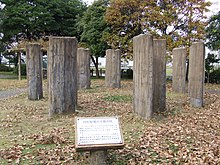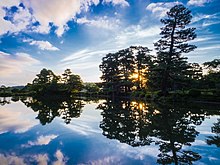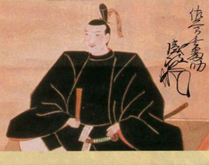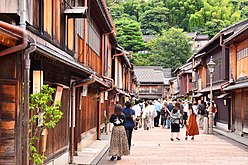
A | B | C | D | E | F | G | H | CH | I | J | K | L | M | N | O | P | Q | R | S | T | U | V | W | X | Y | Z | 0 | 1 | 2 | 3 | 4 | 5 | 6 | 7 | 8 | 9
Kanazawa
金沢市 | |||||||||
|---|---|---|---|---|---|---|---|---|---|
| |||||||||
 Location of Kanazawa in Ishikawa Prefecture | |||||||||
| Coordinates: 36°33′39.8″N 136°39′23.1″E / 36.561056°N 136.656417°E | |||||||||
| Country | Japan | ||||||||
| Region | Chūbu (Hokuriku) | ||||||||
| Prefecture | Ishikawa Prefecture | ||||||||
| Government | |||||||||
| • Mayor | Takashi Murayama (from March 2022) | ||||||||
| Area | |||||||||
| • Total | 468.64 km2 (180.94 sq mi) | ||||||||
| Population (January 1, 2018) | |||||||||
| • Total | 466,029 | ||||||||
| • Density | 990/km2 (2,600/sq mi) | ||||||||
| Time zone | UTC+09:00 (Japan Standard Time) | ||||||||
| City symbols | |||||||||
| Tree | Prunus mume | ||||||||
| Flower | Iris Salvia splendens Begonia Impatiens walleriana Pelargonium | ||||||||
| Phone number | 076-220-2111 | ||||||||
| Address | 1-1-1 Hirozaka, Kanazawa-shi, Ishikawa-ken 920-8577 | ||||||||
| Website | Official website | ||||||||
Kanazawa (金沢市, Kanazawa-shi) is the capital of Ishikawa Prefecture in central Japan. As of 1 January 2018[update], the city had an estimated population of 466,029 in 203,271 households, and a population density of 990 persons per km2.[1] The total area of the city was 468.64 square kilometres (180.94 sq mi).
Etymology

The name "Kanazawa" (金沢, 金澤), which literally means "marsh of gold", is said to derive from the legend of the peasant Imohori Togoro (literally "Togoro Potato-digger"), who was digging for potatoes when flakes of gold washed up. The well in the grounds of Kenroku-en is known as 'Kinjo Reitaku' (金城麗澤) to acknowledge these roots. The area where Kanazawa is was originally known as Ishiura, whose name is preserved at the Ishiura Shrine near Kenrokuen. The area around Kanazawa was part of ancient Kaga Province.
History
Muromachi period
During the Muromachi period (1336 to 1573), as the powers of the central shōguns in Kyoto was waning, Kaga Province came under the control of the Ikkō-ikki, followers of the teachings of priest Rennyo, of the Jōdo Shinshū sect, who displaced the official governors of the province, the Togashi clan, and established a kind of theocratic republic later known as "The Peasants' Kingdom." Their principal stronghold was the Kanazawa Gobo, on the tip of the Kodatsuno Ridge. Backed by high hills and flanked on two sides by rivers, it was a natural fortress, around which a castle town developed. This was the start of what would become the city of Kanazawa.
Sengoku period
In 1580, during the Sengoku period (1467 to 1615), Oda Nobunaga sent Shibata Katsuie, and his general Sakuma Morimasa, to conquer the Kaga Ikko-ikki.[2]
After overthrowing the "Peasant's Kingdom", Morimasa was awarded the province as his fief. However, after the assassination of Oda Nobunaga in 1582, he was displaced by Maeda Toshiie, who founded Kaga Domain. At the Battle of Sekigahara in 1600, Maeda sided with Tokugawa Ieyasu and thus was able to further enlarge his holdings to a massive 1.2 million koku — by far the largest feudal domain within the Tokugawa shogunate. The Maeda clan continued to rule Kaga Domain from Kanazawa Castle through the end of the Edo period.
Edo period

Maeda Toshiie and his successors greatly enlarged Kanazawa Castle and carefully planned the layout of the surrounding jōkamachi to meet strategic and defensive concerns.[citation needed] On April 14, 1631, a fire consumed much of the city, including the castle.[citation needed] In 1632 Maeda Toshitsune ordered the construction of a canal to bring water from the upper Sai River to the castle to alleviate a water shortage problem. Water was drawn from far upstream, and channeled through kilometres of canals and pipes carefully laid at a 750:1 slope for about 3.3 kilometres (2.1 miles) to the castle.[citation needed] The water was fed to the castle under the moat that lay between it and what is now Kenrokuen by an artesian well. The large lake in Kenrokuen, Kasumi-ga-Ike, acted as an emergency supply. Local legend has it that the lake has a plug, which could be pulled to increase the water in the moats. The series of moats were laid out in the early seventeenth century. Initially they were dry, but later connected to the rivers. The Inner Moat was dug in only 27 days, and averaged about four to five feet wide. The Outer Moat took a bit longer, and averages some six to nine feet in width. Though much of the Inner Moat has been filled in, large sections of the Outer Moat remain. The earth removed from the moat was piled into ridges along the inner side, as an added defence measure.

Before the Maeda clan arrived in Kanazawa, the town had a population of only 5,000.[3] However, thanks to Maeda efforts, that number rose quickly. By 1700, Kanazawa rivaled Rome, Amsterdam, and Madrid in size with its population of over 100,000.[4] The Maeda summoned samurai retainers to live in Kanazawa and offered a set of incentives to attract the artisans and merchants needed to support the samurai population.[5] Chartered merchants and artisans received economic, social, and political privileges in exchange for moving to the city: they were guaranteed business, exempt from certain taxes, and given pieces of land for shops and residences.[6] These merchants and artisans were at the top of the chōnin, or townsman, social class.
Other merchants and artisans, who made up the rest of the chōnin, came without such promises. Some were first hired as servants for samurai or wealthy merchant families and decided to stay in the city even after their contracts expired, though most moved to Kanazawa for no reason other than the commercial opportunities the city presented. The government further facilitated growth by responding to the needs of these newcomers with projects like the Sai River Project. Because the Sai River split in two and the castle was located in the center, a part of the riverbed was unusable. In the 1610s, the construction project diverted the secondary stream into the main river, thus creating usable land, where four new wards opened for chōnin settlement.[7] Some of these poorer merchants became successful enough to compete with chartered merchants for city administration positions, but many supported themselves by making and selling low cost goods, such as umbrellas and straw sandals, for mass consumption. This signifies that the commoner population of Kanazawa began to generate its own consumption demands, thus stimulating even more growth.[8]
Kanazawa flourished largely because of a mutually beneficial relationship between the daimyō and the chōnin. The samurai relied on merchants and artisans for goods and services, while the chōnin were able to thrive because of the protection that the daimyō provided. Coming out of the Sengoku Period, castle towns were particularly appealing because of their security and defenses.[9] Kanazawa's growth was indicative of a larger trend in Japan from 1580 to 1700: urbanization. In those 120 years, the population of the country nearly doubled, reaching approximately 30,000,000, and the percentage of people living in urban towns of more than 10,000 residents grew more than tenfold.[10] Kanazawa continued to grow until 1710, when the chōnin population reached 64,987, and the city's total reached approximately 120,000. The population then stabilized.[11] Much of the economic and population growth in Kanazawa, as well as in other Japanese castle towns, occurred during Japan's closed country policy (sakoku). Beginning in the 1630s, Japan had little or no influence from other countries. However, this phase was clearly not a sign of backwardness or decline. The growth that Japan experienced while operating under sakoku policy was largely possible because of castle towns such as Kanazawa.[citation needed] They facilitated growth in a way that did not require foreign influence, thus contributing to the success and stability of Japan at the time.
The vast wealth of the Maeda was channeled into arts and crafts, rather than military pursuits, and Kanazawa became the centre of the "Million-koku Culture", which helped ease suspicions held by the shogunate over the domain's wealth and the status of its daimyō as an "Outer Lord" or Tozama daimyō.[citation needed] The third daimyō Maeda Toshitsune, formed the "Kaga Workmanship Office" and promoted lacquer and gold-and-lacquer-work; and the fifth daimyō, Maeda Tsunanori, collected works of art and artisans from all over the country.[citation needed] Kanazawa was one of the largest cities in Japan throughout the Edo period.[citation needed]
-
Nagamachi Buke Yashiki District
-
Kazue Machi
-
Higashiyamahigashi (Higashi-Chaya)
-
Nishi Chaya-gai (Nishi-Chaya)
Meiji period
Following the Meiji restoration, the modern city of Kanazawa was created on April 1, 1889, with the establishment of the modern municipalities system. The borders of the city gradually expanded by annexing neighbouring towns and villages bringing the area of the city from its initial 10.40 square kilometers to its present 468.64 square kilometers.
-
The Fourth High School Memorial Museum of Cultural Exchange, Ishikawa
-
Kanazawa Literary Hall
Heisei period
On April 1, 1996, Kanazawa was proclaimed a Core city with increased local autonomy.[citation needed]
Government

Kanazawa has a mayor-council form of government with a directly elected mayor and a unicameral city legislature of 38 members. Since March 2022 the mayor is Takahasi Murayama. His predecessor was Yukiyoshi Yamano who had been mayor since December 2010.[12] Yamano resigned to run for the seat of governor of Ishikawa prefecture.
The city is the seat of the Ishikawa Prefectural Assembly, and contributes 16 of the 43 members of that body.
In terms of national politics, the city forms the Ishikawa 1st District with one seat in the lower house of the Diet of Japan.
Geography

Kanazawa is located in north-western Ishikawa Prefecture in the Hokuriku region of Japan and is bordered by the Sea of Japan to the west and Toyama Prefecture to the east. The city sits between the Sai and Asano rivers. The eastern portion of the city is dominated by the Japanese Alps. Parts of the city are within the borders of the Hakusan National Park.
Climate
Kanazawa has a humid subtropical climate (Köppen Cfa) characterized by hot, humid summers and cold winters with heavy snowfall.[13] Average temperatures are slightly cooler than those of Tokyo, with means approximately 4 °C (39 °F) in January, 12 °C (54 °F) in April, 27 °C (81 °F) in August, 17 °C (63 °F) in October, and 7 °C (45 °F) in December. The lowest temperature on record was −9.4 °C (15.1 °F) on January 27, 1904, with a maximum of 38.5 °C (101.3 °F) standing as a record since September 8, 1902.[14] The city is distinctly wet, with an average humidity of 73% and 193 rainy days in an average year. Precipitation is highest in the autumn and winter; it averages more than 250 millimetres (10 in)/ month November through January when the Aleutian Low is strongest, but it is above 125 millimetres (4.9 in) every month of the year.
| Climate data for Kanazawa (1991−2020 normals, extremes 1882−present) | |||||||||||||
|---|---|---|---|---|---|---|---|---|---|---|---|---|---|
| Month | Jan | Feb | Mar | Apr | May | Jun | Jul | Aug | Sep | Oct | Nov | Dec | Year |
| Record high °C (°F) | 21.2 (70.2) |
23.6 (74.5) |
27.1 (80.8) |
31.6 (88.9) |
33.7 (92.7) |
36.1 (97.0) |
37.4 (99.3) |
38.3 (100.9) |
38.5 (101.3) |
33.1 (91.6) |
28.4 (83.1) |
24.7 (76.5) |
38.5 (101.3) |
| Mean daily maximum °C (°F) | 7.1 (44.8) |
7.8 (46.0) |
11.6 (52.9) |
17.3 (63.1) |
22.3 (72.1) |
25.6 (78.1) |
29.5 (85.1) |
31.3 (88.3) |
27.2 (81.0) |
21.8 (71.2) |
15.9 (60.6) |
10.2 (50.4) |
19.0 (66.2) |
| Daily mean °C (°F) | 4.0 (39.2) |
4.2 (39.6) |
7.3 (45.1) |
12.6 (54.7) |
17.7 (63.9) |
21.6 (70.9) |
25.8 (78.4) |
27.3 (81.1) |
23.2 (73.8) Zdroj:https://en.wikipedia.org?pojem=Kanazawa,_Ishikawa Text je dostupný za podmienok Creative Commons Attribution/Share-Alike License 3.0 Unported; prípadne za ďalších podmienok. Podrobnejšie informácie nájdete na stránke Podmienky použitia.
Analytika
Antropológia Aplikované vedy Bibliometria Dejiny vedy Encyklopédie Filozofia vedy Forenzné vedy Humanitné vedy Knižničná veda Kryogenika Kryptológia Kulturológia Literárna veda Medzidisciplinárne oblasti Metódy kvantitatívnej analýzy Metavedy Metodika Text je dostupný za podmienok Creative
Commons Attribution/Share-Alike License 3.0 Unported; prípadne za ďalších
podmienok. www.astronomia.sk | www.biologia.sk | www.botanika.sk | www.dejiny.sk | www.economy.sk | www.elektrotechnika.sk | www.estetika.sk | www.farmakologia.sk | www.filozofia.sk | Fyzika | www.futurologia.sk | www.genetika.sk | www.chemia.sk | www.lingvistika.sk | www.politologia.sk | www.psychologia.sk | www.sexuologia.sk | www.sociologia.sk | www.veda.sk I www.zoologia.sk | ||||




















